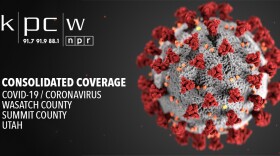The Utah Department of Health reported Thursday there are 78 confirmed cases of COVID-19 in Utah, with Summit County and Salt Lake County shouldering the brunt of the cases.
As of Thursday afternoon, Summit County has 26 total cases — 19 of those are residents, and seven are visitors. Only Salt Lake County has more at 31 cases. State Epidemiologist Angela Dunn explained why.
“It was expected that we would see a lot of cases in Salt Lake County — it is our most urban area," Dunn said. "Summit County really started with all the tourism, and so that’s how their local outbreak started.”
Because it’s a new disease, there’s still a lot to learn about COVID-19. Dunn says scientists don’t yet know if people build immunity to the disease after they get it, like with the seasonal flu, and health officials don’t know how long the pandemic will last. However, Dunn says most pandemics go through several phases.
“First is the buildup phase, then you get an acceleration where cases are increasing exponentially and then a downward phase," Dunn said. "Usually, those disease processes take several months. The lieutenant governor’s task force will make the decisions based on social distancing enforcements and take into account the expected progression of the outbreak.”
So far, more than 1,500 people have been tested for COVID-19 in Utah. Although testing is increasing with more commercial labs coming online, Dunn says availability is still limited. She says it’s important to test early on to identify what’s going on, but many people with mild symptoms don’t qualify for testing. That’s why the state has carried out large-scale health interventions.
“That’s what we’re doing now is implementing these school closures and mass gathering restrictions statewide, in order to ensure that those who might have mild symptoms and aren’t tested for COVID-19 are not able to spread it to others,” Dunn said.
In another attempt to slow the spread of disease, on Wednesday Utah Gov. Gary Herbert issued three executive orders in response to COVID-19. The first allows bars and restaurants to return product back to the Dept. of Alcoholic Beverage Control, in response to Herbert’s order Tuesday to prohibit dine-in service at food establishments. The second allows the public to remotely view hearings from the Board of Pardons and Parole. The last allows public meetings to be conducted electronically.




